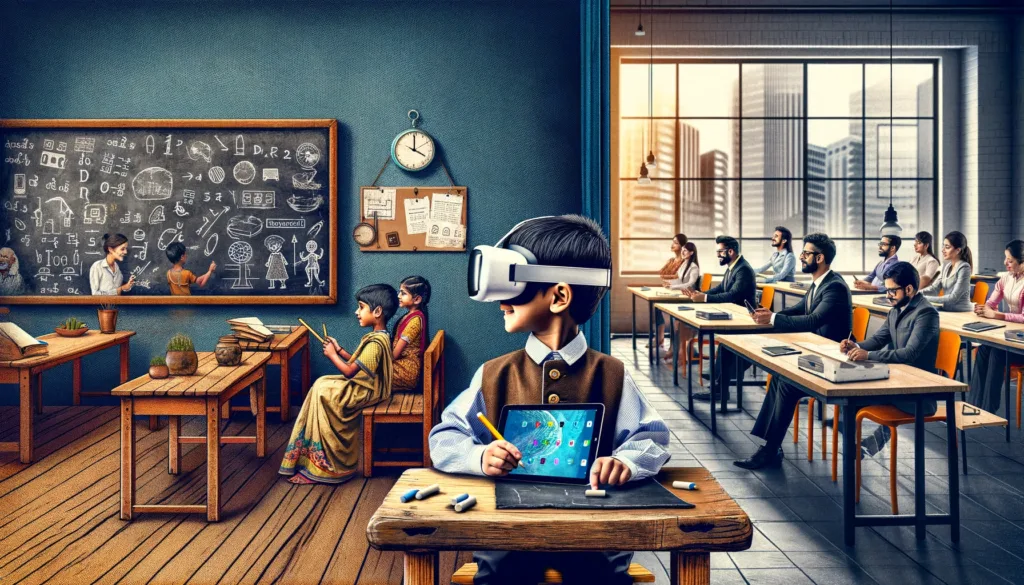Table of Contents

Introduction: The Evolution of Educational Tools
My Father-in-Law can still remember how he used to write on a slate tablet with chalk in his junior classes. Well, things have changed a lot since then, enter Digital Learning Technologies. In the early 1920s across schools in India, books and paper replaced the old mud tablets or slates that children (especially in rural India) used for writing. The day is not far away when most books will be replaced by electronic tablets. BYOD (Bring Your Own Device) will be a natural state in schools and education across the world.
The Current State of Digital Learning Technologies
The technology and infrastructure already exist, but the overall education system is still playing catch-up – usable content and competent instructors and guides are the bottlenecks. Imagine a world where the first time a child is introduced to Harry Potter, she (or he) can put on their VR glasses and get to experience a real-life Quidditch match, or a child reading Oliver Twist is transported to 19th-century England… for the first time in human history, really immersive learning experiences are available to the general public at an affordable price point. But as with everything else, there is still some work to be done.
Exploring the Available Digital Learning Technologies
Augmented Reality (AR): Enhancing Real-World Learning
- Think… Pokemon Go. If you ever played this addictive game when it was all the rage you will be able to relate. It is, in essence, a virtual overlay of the real world. Do you remember learning the “structure of a leaf” when you were in class 5? What if, you had an app on your phone, which, when you point your camera at a leaf, is able to show you, in 3-D the structure of the leaf, with its individual components marked and labeled? This is called AR or Augmented Reality. In this format, you are observing the world around you through a “lens” which labels and explains the features and aspects of the object you are examining. The technology for this is advanced and is already being used to enhance your shopping experience and in numerous games.
Virtual Reality (VR): Immersive Learning Experiences
- This is a more immersive experience, you become a part of the world you are inhabiting. The closest thing you’ve probably experienced is watching a 3-D movie, but imagine being able to interact with your environment, open and shut doors, and feel like you are flying on a broomstick. When Harry Potter enters the “Pensieve” in Harry Potter and the Half-Blood Prince, he becomes a part of the experience. This experience is recreated in the VR world. This technology is already being used by organizations to conduct induction programs for their employees and by real estate agents selling houses. In learning, it can be used to allow children to play virtual ‘doctor-doctor” and learn the different human systems, to enter space and experience the solar system, or become a microbe and get into the structure of a leaf and look at it from the inside. This is the most experiential of experiential learning.
Artificial Intelligence (AI): Personalized Learning Assistants
- The next agent of digital disruption in learning has a name… or many names… and children have already made friends with it (or them) – Siri, Alexa, Cortana, Bixby. AI or artificial intelligence-based personal assistants lie dormant in your phone, speaker, or laptop, ready to help you when you need them. Now, we’ve all experienced how well they work (or sometimes don’t). With continuous improvements in what’s called Machine Learning and Natural Language Processing, this will soon get better and better.
Gen AI: The Future of Learning Assistance
The almost overnight evolution of Gen AI has accelerated this journey. The number of apps that are now being designed to leverage this disruptive technology has transfigured the landscape of digitally assisted learning. Over time, these GenAI-based tools will become an irreplaceable part of our lives and will soon become the single most important information search tool for the next generation. Imagine uploading your entire chapter to an app and then asking it any question you want on the subject matter and getting the most accurate answer.
Challenges in Implementing Digital Learning Technologies
All of this sounds wonderful, so why isn’t it becoming as ubiquitous as the mobile phone itself? As with everything in life, there are still some challenges to this technology. For starters, while everyone who has anything to do with technology is working on creating AR and VR-ready content and AI is being integrated into every aspect of our lives, it’s still going to take some time for it to be at a level where it can truly augment and eventually replace the immense body of knowledge that exists in a 2-D digital format. This is still a very expensive, time-intensive, and expertise-driven process. It takes a sophisticated team of coders, graphic designers, and content writers to add that other dimension to these elements. But it is a one-time effort and when it is done, there will be nothing to stop it from becoming more and more affordable.
Health and Well-Being Considerations
The second, and probably the bigger concern, is the impact of constant use of technology on our health and well-being, and this is where designers need to use their “smarts”. What trumps all of the other aspects of this kind of technology is its ability to function outside the classroom as well as in it. It is the holy grail of continuous learning. Used and designed properly, it might even be the one thing that gets children and even adults out of their rooms and into the real world, experiencing it through the lens of the thing that adults find hardest to get out of their children’s hands – the mobile phone.
The Future of Digital Learning Technologies
It took the makers of Avatar almost 10 years and a ton of innovation to create the first true motion capture technology which works on a virtual stage and create a truly immersive experience. Once that technology was invented, it took the makers of Life of Pi a lot less time to make their movie. As we work on creating and building better technology both hardware and software to make AR, VR, and AI truly accessible to everyone, we will see more and more people ready and willing to incorporate these aspects into their learning environments and ecosystems.
Transform Your Learning Experience with Breakfree Consulting
What are you waiting for? Get ahead of the curve and start your virtual experiential journey with BreakFree Consulting (I) Pvt Ltd. We specialize in helping organizations create cutting-edge content, systems, and infrastructure to harness the power of digital learning technologies.
Feel free to reach out to Breakfree Consulting (I) Pvt Ltd for consulting and outsourcing services on integrating these advanced technologies into your educational framework. Let us guide you through the transformative journey of digital education and business innovation.
Conclusion
As we stand on the brink of a new era in education, the integration of AR, VR, and AI is set to revolutionize how we learn and teach. These digital learning technologies offer immersive, engaging, and highly interactive experiences that can transform traditional educational methods. From bringing the magical world of Harry Potter into the classroom to providing real-world learning simulations, the possibilities are endless. BreakFree Consulting (I) Pvt Ltd is here to help you navigate this exciting transition, providing the expertise and support needed to create a cutting-edge learning environment. Embrace the future of education today and stay ahead in the rapidly evolving landscape of digital learning.
FAQs
Q1: What are digital learning technologies? A: Digital learning technologies include tools and platforms such as AR (Augmented Reality), VR (Virtual Reality), and AI (Artificial Intelligence) that enhance and transform the educational experience by making learning more interactive and immersive.
Q2: How can AR and VR be used in education? A: AR can overlay digital information onto the real world, helping students visualize complex concepts, such as the structure of a leaf in 3D. VR provides immersive experiences, such as virtual field trips to historical sites or interactive simulations of scientific experiments, allowing students to engage deeply with the material.
Q3: What is the role of AI in education? A: AI in education can provide personalized learning experiences, automate administrative tasks, and offer intelligent tutoring systems that adapt to the individual needs of students, enhancing their learning outcomes.
Q4: What are the benefits of using these technologies in education? A: The benefits include increased engagement, improved retention of information, personalized learning experiences, and the ability to simulate real-world scenarios for practical learning. These technologies also make learning more accessible and inclusive.
Q5: Are there any challenges in implementing digital learning technologies? A: Yes, challenges include the high cost of development and implementation, the need for technical expertise, and potential health impacts from prolonged use. However, as technology advances and becomes more affordable, these challenges are expected to diminish.
Q6: How can BreakFree Consulting help with the integration of these technologies? A: BreakFree Consulting offers expertise in creating and implementing digital learning content, systems, and infrastructure. We guide organizations through the process of integrating AR, VR, and AI into their educational frameworks, ensuring a smooth transition and effective use of these technologies.
Q7: How can small and medium businesses benefit from Gen AI? A: Gen AI can help small and medium businesses by providing advanced data analysis, automating customer interactions, and creating personalized marketing strategies, thereby increasing efficiency and competitiveness.
